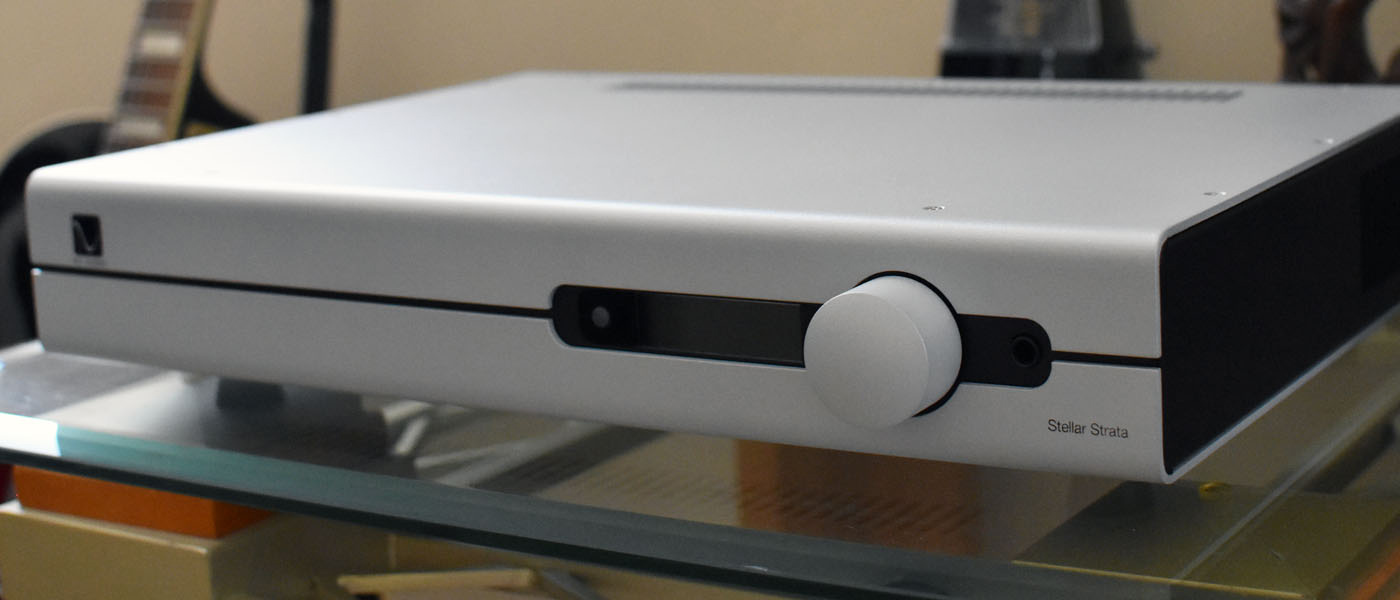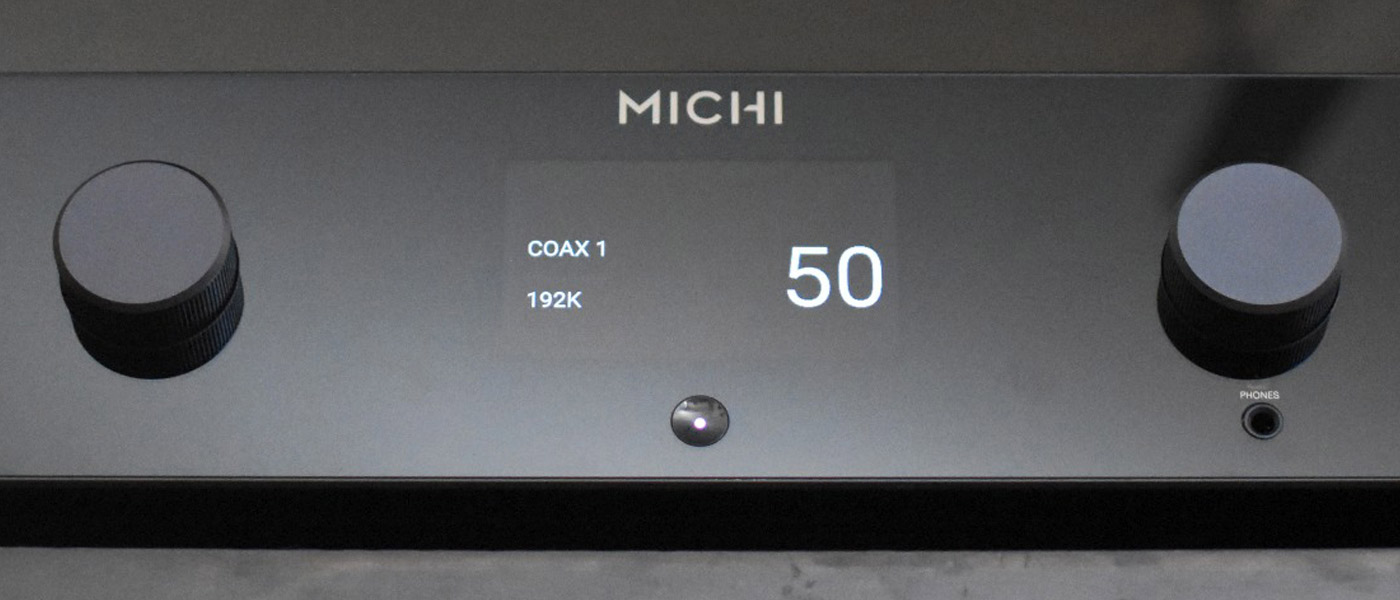
The Michi brand was introduced in 1990s as part of Rotel’s effort to elevate its entire business. Products under the original Michi brand were designed to exceed the technical and acoustic requirements of the regular Rotel product lines. They were intended to provide a path (‘michi’ is Japanese for ‘path’) for Rotel as a company to gain global market recognition in higher-end audio components. Michi’s products were iconic, but as the company went through a period of instability, the effort to further develop products under the Michi brand subsided and the brand became dormant. At the end of last year, Rotel decided that it was the appropriate time to revive the Michi brand with the introduction of three flagship-level products: P5 preamplifier ($3999), S5 stereo amplifier ($6999), and M8 Monoblock amplifier ($6999). In August 2020, two new integrated amplifiers were introduced in the Michi line: the X5 ($6999) and X3 ($4999), with availability starting in November 2020 for the X5 and October 2020 for the X3.
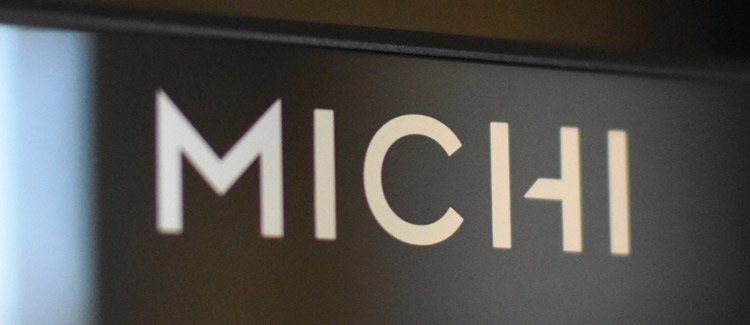
The Michi X3 reviewed here has a clean and elegant appearance that may deceivingly hide the fact that it is a feature-laden modern advanced integrated amplifier. It can switch and process analog and digital signals, the latter is powered by an AKM premium 32-bit/768-kHz DAC chip. The X3 can handle PCM signals up to 32-bit/384-kHz and DSD signals up to 5.6 MHz (DSD128) through its USB input. It also features a MM phono stage and Bluetooth with AptX for wireless music playback. Its internal amplifier is a class AB design and capable of delivering 200 W/channel into 8-ohm or 350 W/channel into 4-ohm loads.
Rotel Michi X3 Integrated Amplifier
- Versatile and feature-laden integrated amplifier.
- Onboard DAC can handle PCM (up to 32-bit/384-kHz) and DSD signals (up to 5.6 MHz).
- Elegant-looking product with excellent build quality and finish.
- Powerful yet refined onboard amplifier.

When the opportunity to review the Michi X3 integrated amplifier was offered to me, I said ‘yes’ in a heartbeat. There was no way I would pass up an opportunity to review a product with such a pedigree. I admit though that I did not know much about Michi, except that it was a higher-end sub-brand of Rotel, sort of the Lexus of Toyota or the Acura of Honda.
Secrets Sponsor
While Rotel products are always about value and designed to meet certain price points, the Michi products carry a different philosophy. The value element is still there, but the Michi line is designed with a flagship mentality. The Michi products are designed to meet the highest technical and acoustical requirements with the aspiration to set new standards in high-end audio components by leveraging the core strengths of Rotel, which include custom-designed in-house built toroidal transformers and high end audiophile-grade components. The core DNA of Rotel with its over 60 years of history leads to the implementation of innovative technology and engineering for the creation of audio components that can achieve the level of performance required to proudly carry the Michi brand.
When the review sample of the Michi X3 arrived, the first thing that caught my attention was the package weight. The sheer weight of the package alone gave an indication that the unit inside should not be taken lightly (literally or non-literally). At 64 lbs, this piece is larger and heavier than the typical integrated amplifier (or even power amplifier) with similar amplification specifications. Thick metal chassis, thick heatsink, and large custom high-current toroid transformer are the main contributors to this hefty weight, which requires special handling. You would need two people to move this around and a strong shelf/foundation to support it. If audio components were judged by the price/pound, you definitely get a lot here for the money.
Amplification:
MAXIMUM POWER OUTPUT:
350W/Ch (4Ω)
CONTINUOUS POWER OUTPUT:
200W/Ch (8Ω)
TOTAL HARMONIC DISTORTION (THD):
<0.008%
FREQUENCY RESPONSE:
Line Level Inputs: 10Hz – 100kHz (+0dB, -0.4dB)
Digital Inputs: 20Hz – 20kHz (0 ± 0.4dB)
Phono Input: 20Hz – 20kHz (+0dB, +0.4dB)
S/N RATIO (IHF “A” Weighted):
Line Level Inputs: 102dB
Digital Inputs: 102dB
Phono Input: 80dB
DAMPING FACTOR (20Hz – 20kHz, 8Ω):
350
CHANNEL SEPARATION:
>55dB
INPUT SENSITIVITY:
Line Level Inputs (RCA): 340mV
Line Level Inputs (XLR): 540mV
Phono Input (MM): 5.2mV
INPUT IMPEDANCE:
Line Level Inputs (RCA): 100kΩ
Line Level Inputs (XLR): 100kΩ
Digital Inputs: 75Ω
Phono Input (MM): 47kΩ
INPUT OVERLOAD:
Line Level Inputs (RCA): 3.5V
Line Level Inputs (XLR): 5.5V
Phono Input: 60mV
PREOUT LEVEL:
1.9V
OUTPUT IMPEDANCE:
100Ω
TONE CONTROLS:
±10dB at 100Hz / 10kHz
DAC:
DIGITAL INPUT SIGNALS:
SPDIF LPCM (Up to 24-bit/192kHz)
PC-USB:
USB Audio Class 1 (up to 24/96)
USB Audio Class 2 (up to 32/384)
DSD and DoP support
General
DIMENSIONS (W × H × D):
485 x 150 x 452mm (19″ × 6″ × 17 3/4″)
POWER REQUIREMENTS:
120V, 60Hz
POWER CONSUMPTION:
500W
STANDBY POWER CONSUMPTION:
Normal: <0.5W, Network Wakeup: <2W
NET WEIGHT:
28.9kg (63.7 lbs.)
BTU RATING:
1303 BTU/h
MSRP:
$ 4999
Website:
Company Directory:
SECRETS Tags:
rotel, macho, x3, integrated, amplifier, amplifier review, review 2020
Beauty is in the eye of the beholder, but to my eyes, the simplicity of the Michi X3 design screams elegance. The combination of the black matte chassis with glossy black glass on the front panel looks classy. It’s front panel especially looks clean with only two round knobs (input selector and volume knobs) flanking the inconspicuous display (only obvious when the display is on), a recessed on/off button, a headphone jack, and a Michi logo on the middle top. Detailed design features, such as ridges surrounding the sides of the knobs and curved edges on the large metal heatsinks that cover the whole left-and-right sides of the product, further add to the overall rugged feel and elegant look of the product. The build quality of the product is impeccable overall.
The side heatsinks bring the total width of the X3 to 19″, which is wider than the typical full-size audio component width of 17″. With a height of 6″ and a depth of close to 18″, even though the X3 is not the largest integrated amplifier in the Michi line (the X5 is larger), the unit’s outer dimensions are relatively larger than most integrated amplifiers on the market. Besides the size, the manual also suggests a minimum of 20″ clearance around the unit for good ventilation. During my evaluation, however, I never found the unit to become extremely warm, even when it was pushed hard, so this clearance suggestion for ventilation might be more on the cautious side. In my opinion, a good 5″ clearance with good air flow all around should be sufficient. But still, for a component with a rather unusual size and weight like this, potential buyers should consider the potential placement for the unit carefully before the purchase.
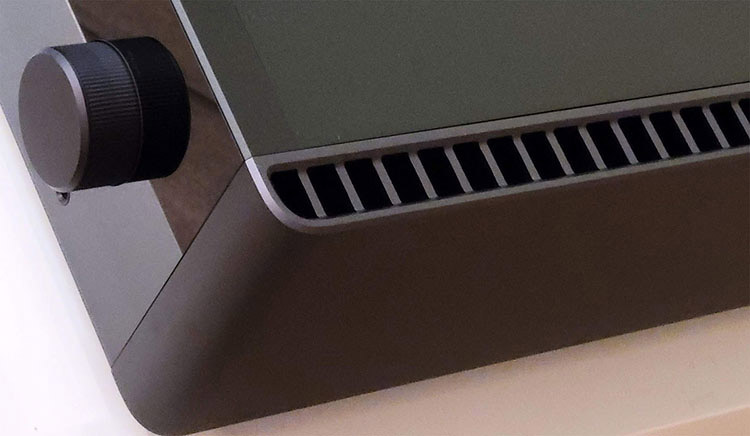
While the simple front panel appearance might hide what the Michi X3 can do, the connectors on the rear panel readily give an indication of its portfolio of features. The presence of the digital input connectors (3 optical, 3 coaxial, and a USB) clearly indicates that the X3 has an onboard DAC and has the capability of processing digital input signals. This capability puts the X3 in the modern integrated amplifier category, which seems to be popular these days. I get why this type of product is gaining popularity. It offers unparalleled convenience as it can simplify one’s system setup by combining at least three separate components (preamplifier, DAC, and power amplifier) into one box. On the analog side, the X3 can accept a set of balanced (XLR) and 3 sets of single-ended line-level stereo inputs. With its onboard phono stage, the unit also features a set of connectors for a Moving-Magnet (MM) phono input. The X3 does not have a Moving-Coil (MC) phono input functionality. The rear panel of the X3 also sports a Bluetooth antenna to support its Bluetooth with AptX wireless streaming capability.

The Michi X3 has two sets of speaker terminals to accommodate bi-wire installations. These speaker terminals are custom-engineered Rhodium plated binding posts, which allow bare wire, spade lugs, or banana plug connections. They look unique and reflect a high level of quality. A set of line-level single-ended stereo outputs and a pair of mono subwoofer outputs are also provided for external power amplifier and subwoofer connections. These mono subwoofer outputs are just full-range left/right sum of the active input signals with no filtering. Besides the above input/output connectors, one can also find the following on the rear panel of the X3: the power receptacle, the main power switch, two 12V trigger outputs, network port (for software update and integration with automation systems), an external remote in jack (for connection to an infrared remote receiver), an RS232 port (for integration with automation systems), and a USB power port (for charging or powering USB devices and software update).

At the heart of the Michi X3’s digital-to-analog signal processing is the AKM premium 32-bit/768-kHz DAC chip, which allows the X3 to handle high-resolution music signals. Using the coaxial/optical connections, the X3 can process up to 24-bit/192-kHz PCM signals. If there is a need to handle higher-resolution signals, then PC-USB connection is the way to go. Using this PC-USB connection, the X3 can process up to 32-bit/384-kHz PCM signals and up to DSD128 signals. DoP support is also provided for devices that do not output native DSD signals.
The X3 also includes a wireless playback convenience feature using Bluetooth with AptX and AAC enhancement. With this feature, users of Spotify, Tidal, Qobuz, or other streaming services can wirelessly stream music through the X3. Due to Bluetooth transfer-rate limitations, the music files will not be processed at their native resolution and rates, such that a tradeoff between playback quality and wireless convenience may come into play. Typically, I utilize the Bluetooth feature in casual listening situations, to quickly play the music from my mobile phone by sending it wirelessly through Bluetooth to the X3.
A quick peek inside the Michi X3 shows its beefy power supply section, which includes a custom-built high efficiency oversized toroidal transformer. The X3’s amplifier is class AB and rated at 200 Watts of continuous power per channel into 8-ohm loads with both channels driven (THD < 0.008%) or 350 Watts maximum into 4-ohm loads. The manual recommends using speakers with impedance of 4 ohms or higher with the amplifier.
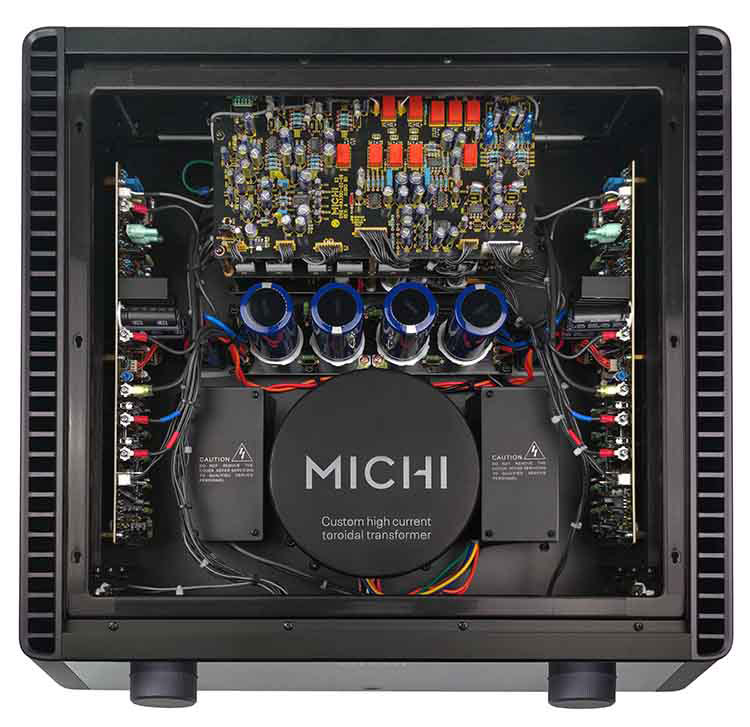
The X3 is supplied with a dark-grey slender metal-body infra-red remote control with plastic buttons, which looks and feels as classy as the unit it controls. The remote can be used to turn the unit on or off, control the volume level/mute, access the setup menu, select input source, adjust tone settings, and dim the display. There is a small white LED backlit in the middle of the remote’s power button, which will illuminate for a few seconds when it is first picked up. The remote is relatively convenient to hold and to use, although sometimes I wished that the backlit was provided on all its buttons. The X3 is quite responsive to the commands from the remote control and covers quite a wide range of command-receiving angles.
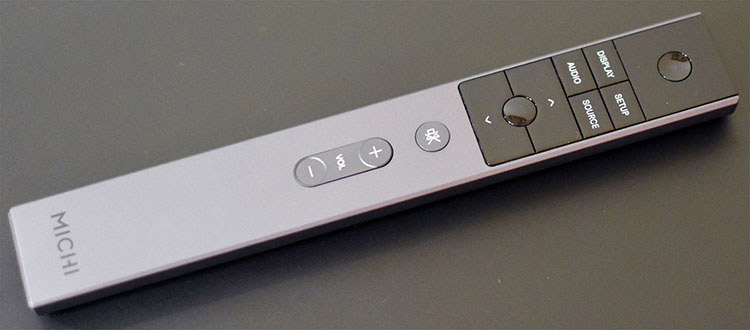
The front panel display of the Michi X3 shows the source selected, volume level, and signal frequency (for digital signals) in clear white digits on a black background. The volume level is especially shown in relatively big numbers and readable from across the room, which is a nice touch. The other information is shown in smaller numbers/letters, but they are still in fairly good size and readable from about 8-9 ft away. This display is dimmable from the remote control or from the setup menu and its default brightness can be adjusted from the setup menu. If it is preferred to have the display off most of the time, the ‘Temporary Display’ feature can be activated from the setup menu with various on-duration options to choose from (5, 10, or 15 seconds). With this feature, the display will only be on for the selected duration when the source input or volume is changed, or when the ‘Display’ button on the remote is pressed.
The manual that comes with the Michi X3 is nicely written and I found it useful for operating some of the amplifier’s advanced features. But just like most integrated amplifiers, the Michi X3 is pretty much plug and play to start up. Just plug in the analog and digital music sources to the appropriate inputs, connect the speaker outputs to a pair of speakers, supply power to the X3, and you are ready to play the music.
The setup menu of the Michi X3, which can be accessed by pressing the ‘Setup’ button on the remote control, provides balance adjustment, tone (bass and treble) control, display and LED brightness control, auto power-off setting, input setting and renaming, power-on volume level, and fixed-volume assignment to specified inputs. The navigation through the setup menu system can be done using the selector knob or from the up/down/select buttons on the remote control. Unused inputs can be disabled through the setup menu, which will make them disappear from the source menu selection. There is no direct input selector from the front panel or from the remote control, so scrolling time to the desired input can be shortened if the unused inputs are disabled. The default audio-mode setting bypasses the tone control, and this was the setting I left it at most of the time. When the audio mode is set to ‘Tone Enabled’, then the bass or treble levels of the playback can be adjusted using the Audio button on the remote control.
Each input of the Michi X3 can be configured to have a variable or fixed volume level. I like this feature as I think it enhances the versatility of the unit. The fixed-volume feature disables the volume level adjustment through the volume knob on the front panel or volume +/- buttons on the remote control. The front display will show ‘FIX’ instead of the volume level when an input with fixed volume setting is selected. This feature can be useful for home-theater bypass, allowing the surround processor to take control of the volume level of the passed-through signals. Applying the fixed-volume feature on one of the analog inputs also allows the Michi X3 to be configured as a stereo power amplifier to complement an external stereo preamplifier. The fixed-volume feature can be applied to its digital inputs so, if desired, the X3 can also serve as a fixed-volume conventional DAC, allowing an external device to control the volume of the playback. Hence, the fixed-volume feature in essence allows the Michi X3 to serve as a ‘separate component’, making it very versatile for applications in various system configurations. I tried the X3 in its ‘separate’ functions during the review and came away impressed. Although I do not foresee that many people who buy the X3 will utilize it in this fashion, let me tell you that in its individual separate function, the X3 is more than capable to give the competing high-end separate components a run for their money.

During the review, I paired the X3 with the Revel Ultima Studio speakers. The front ends I used were Auralic Aries G1 streamer (to stream Qobuz, Tidal, and my CD collections in my local NAS), PS Audio PerfectWave Transport, and Rega Planar 1 turntable. Occasionally I used my Dell XPS13 laptop to stream music via its USB port and my Samsung Galaxy Note20 mobile phone to wirelessly stream music from Spotify or Qobuz via Bluetooth connection. The output of the PS Audio PerfectWave DAC II connected to the digital sources above was also used for comparison to provide analog signals to the X3. I found that the X3 was very adept in handling the digital signals and had no issues in decoding the digital signal inputs within its specifications. Its USB connection was recognized immediately by the Auralic Aries G1 or by the Dell XPS13 laptop running Windows 10 as Michi USB 2.0, so no further setup was needed to take advantage of the high-resolution signal processing speed capability of the X3’s internal DAC.
Having reviewed a Rotel product not too long ago (the A14 integrated amplifier), I approached the Michi X3 with some expectation on the ‘house’ sonic signature, even though I knew they were not in the same price bracket ($1499 for the A14 vs $4999 for the X3). The sonic characteristics of the Rotel A14 tilted slightly towards brightness and so I expected to find some resemblance, even if ever so slightly, on the sonic characteristics of the X3. But I could not be more wrong in this case! There was not even a trace of tilt towards brightness I heard from the X3, which I found to be neutral. Compared to the A14, the X3 just sounded more refined and smoother with higher level of musicality.
Operationally, the Michi X3 was quite robust, handling analog as well as digital signal playback extremely well. The X3 capability in maintaining the purity of the analog signals for transparent and dynamic sonic delivery was outstanding. In a way, I was expecting this from a high-end integrated amplifier of the X3 caliber. What I did not expect was the excellence that the X3 demonstrated in processing the digital music signals using its onboard DAC. The implementation of the AKM premium 32-bit/768-kHz DAC chip in the X3 produced first-rate sound that could rival the performance of an expensive separate DAC box. In fact, in my system, I had a slight preference toward the sonic outcome from the X3’s internal DAC than the results through the PS Audio PerfectWave DAC II (Note: the PerfectWave DAC II had an MSRP of $4000 and is a PCM only DAC), which I had used as a review reference for some time now. In my opinion, the X3’s DAC produced a tad better rendition of details and slightly more transparent than the PerfectWave DAC II.
The first moment I fired up the Michi X3, I immediately knew I was listening to something special. It was not every day that such an impression has come to me during many years reviewing audio components. In fact, I could not remember when I experienced it the last time prior to this review. The X3 got me hooked immediately and indulged me with its musical presentation through the Revel Ultima Studio speakers. Call it love at first listen if you will, but everything just sounded so right to my ears: the tonal balance across the audible frequency spectrum, the dynamics, the details in the music, the musical texture, and the soundstage presentation. It was just like the X3 knew what I wanted in my music and delivered it on a gold platter.
Symphonic Suite, Kiki’s Delivery Service (2020)
First of all, the Michi X3 exhibited great dynamics and great tonal balance across the whole audible frequency spectrum. Midrange sounded steady and smooth, treble was airy and extended, and bass definition was excellent. There was a high sense of musicality in the overall X3’s sonic presentation, which highlighted its knack in navigating through complex musical passages effortlessly. On the rendition of On a Clear Day – A Town with an Ocean View by Joe Hisaishi & New Japan Philharmonic World Dream Orchestra from the live-recording album Symphonic Suite “Kiki’s Delivery Service” (2020), the whole musical presentation sounded dynamic and grand through the X3. The details and imaging were so mesmerizing, making me feel I could pick out each individual instrument from its location in the stage of the orchestra. The X3 preserved the texture of the music extremely well allowing me to get absorbed into the flow of emotion in the music.
Imelda May, Life Love Flesh Blood (2017)
The sonic aspects of the Michi X3 that impressed me the most were the palpability and the three-dimensionality of the soundstage presentation. The Revel Ultima Studio speakers are great speakers in the imaging department to begin with, and the X3 seemed to make the speakers disappear easier and elevate their soundstage presentation to a whole new level. The soundstage rendition of the tracks Call Me and Black Tears from Imelda May’s Life Love Flesh Blood (2017) album through the X3 was the best that I had ever experienced in my setup. The amplifier produced spacious phantom-image with a clear sense of space between instruments that was so palpable. The X3’s portrayal of the soundstage was wide and deep while still maintaining the individual image focus for the vocal and instruments in the music.
Diana Krall, The Look of Love (2001)
In general, vocals in music sounded natural and full-bodied through the X3. This made the presentation of Diana Krall’s voice in the track Besame Mucho from her album The Look of Love (2001) so lifelike. Moreover, with its strong imaging, the X3 projected her voice with a sense of three-dimensionality that I rarely experienced. The background orchestra in this track sounded rich and full of textures with a great stage realism. In the track ‘S Wonderful from the same album, the X3 clearly demonstrated its complete prowess in navigating through the treble, mid-range, and bass effortlessly, creating a very musical and involving presentation. The Michi X3 was not the most powerful amplifier that I have tried, but it had sufficient control over the Ultima Studio’s woofers to allow me to experience among the most well-defined bass response I can recall.
Ed Sheeran, Divide (2017)
I am not a vinyl guy, but I am glad to report that the MM phono stage in the Michi X3 is not just an afterthought. It produced dynamic and clean sounds that were rich in texture. The track Dive by Ed Sheeran from his Divide (2017) LP sounded lively with good balance across the frequency spectrum. The X3 rendered Ed Sheeran’s vocal in the track with the level of naturality that was above and beyond the rendition of other components with built-in phono stages that I have ever tried in my system. The treble details were satisfying, and the bass notes were full and well-defined. The soundstage portrayal on the vinyl playback was good, although it was not as spectacular as the playback through analog line-level or digital sources, as I mentioned earlier. But take this observation with a grain of salt, as my vinyl playback device was not as sophisticated as my digital playback devices.
I was also pleasantly surprised to find that the wireless Bluetooth playback through the Michi X3 sounded better than expected. Streaming Qobuz through Bluetooth from my Samsung Note20 mobile phone, I obtained a sonic quality that was remarkably close to the sound quality that I got through CD or network (LAN or Wi-Fi) streaming playback, even though Bluetooth is not capable of processing signals at full resolution due to its transfer-rate limitation. Because of the sound quality and convenience, I found myself using this feature a lot on the Michi X3 for casual music listening.
Even the headphone feature on the Michi X3 is no slouch. Music through the Massdrop X Sennheiser HD6XX headphones, connected to the X3 headphone jack, sounded transparent and rich in details. The sonic balance across the frequency spectrum was nothing short of excellent. The bass definition and fullness were about the best I have listened to using headphones.
With second-to-none build quality and no-compromise sonic performance, the versatile Michi X3 integrated amplifier represents one of the best in its class far more than its price tag would suggest.
- Elegant-looking and excellent build quality
- Versatile product with strong all-around performance
- Superior music delivery through both analog and digital inputs
- DAC is capable of processing up to 384 kHz PCM and 5.6 MHz DSD signals
- Awesome sonic performance
- Backlit remote control
In the hierarchy of music system performance, a separate-component system is the way to go to achieve the top of the hi-fi pyramid, or so I thought, until I tried the Michi X3 integrated amplifier. With a trick or two, the Michi X3 changed my opinion drastically and showed that an integrated component can also belong fair and square on the top of the hi-fi pyramid. Skillfully engineered with a seemingly cost-no-object mentality, the Michi X3 exhibits excellence by any standard in all aspects of sonic performance. Kudos to the Rotel Michi engineering team to create such a solid product with no obvious weaknesses in its performances. It is also elegant looking with build and finish quality that seem to spare no compromise. Moreover, as a modern integrated amplifier with DAC functionality, the X3 offers a great deal of setup convenience by leaving out the headache of finding matching components, as well as removing interconnects from the equation. The X3 is also incredibly versatile as it can function as a preamplifier/DAC (to be paired with an external power amplifier) or a power amplifier (to accept output from an external preamplifier through a fixed-volume input).
Secrets Sponsor
The Michi X3 is not exactly cheap at $4999, but in my honest opinion, it is worth every penny and more. The components used and the craftmanship of the X3 can beat some of the more expensive products out there. Moreover, it delivers awesome sonic performance that begs to be compared with the best in its class. For these reasons, I consider the X3 one of the best bargains in audio. It is one of the best modern integrated amplifiers that I have ever encountered, and it easily earns my highest recommendation.


